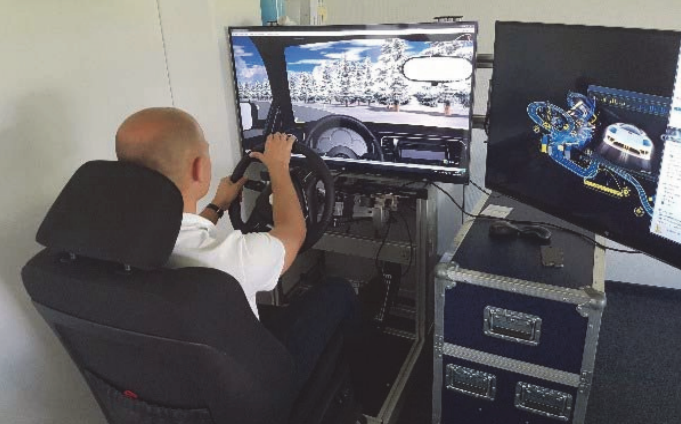| Student | Andrei Aksjonov |
| Supervisors | Valery Vodovozov, Eduard Petlenkov |
| Keywords | driver distraction, artificial intelligence, road safety, antilock braking system, fuzzy logic |
| Degree | PhD |
| Thesis language | English |
| Defense date | June 27, 2019 |
| Document link | Download Thesis Document |
Research and Development of Computational–Intelligence–Based Safety Systems for Ground Vehicles
Abstract
Traffic accidents have a terrible impact on societal, environmental, and economical norms all over the world. Unfortunately, the number of deplorable road accidents does not decrease annually even with constant advancements in transportation and road security. To raise the safety systems of ground vehicles to a new advanced level, vehicle–environment–driver interaction is of high importance. To some extent, due to problem uncertainty and complexity, multiple restrictions are caused by lack of intelligent control methods, what requires multidisciplinary solutions not attainable by classical controllers. Nonetheless, novel computational intelligence algorithms (i.e. artificial neural networks, fuzzy system, etc.) open a great opportunity for managing and creating synergy between complex stochastic plants and human factor. These algorithms provide capability to approximate qualitative aspect of human reasoning and decision–making process in human-machine-environment systems.
Hence, the motivation of this research is to significantly improve such essential and comprehensive ground vehicle safety modules, as antilock braking system and driver distraction detection and evaluation system, applying the computational intelligence approaches. On one hand, the antilock braking system complexity is caused by many nonlinearities, such as the hydraulic brake circuit dynamics and the tire–road adhesion coefficient characteristic, which considerably depends on road states (i.e. weather conditions and quality of the surface, temperature, etc.), as well as on vehicle conditions. On the other hand, driver distraction hardship is resonated with human factor, which is unpredictable and very comprehensive to deal with.
The developed antilock braking system control method accompanied with advanced torque blending strategy competently identifies the road surface and supplies optimal braking torque to each wheel for braking force maximization on varying driving conditions. Besides, the method utilizes electric actuators on their full potential to guarantee supreme energy recuperation under dynamically changing environment. It leads to vehicle steerability preservation, braking distance decrease, and maximum energy recuperation on highly changing road surfaces, what in its turn consolidates vehicle, occupants, and environmental safety at once. Accordingly, the new driver distraction detection and evaluation method based on the driver–vehicle interaction model provides minimization of secondary task impact on safe vehicle operation and traffic accidents, as well as human life protection. The machine–learning–based personalized detection method is unique for each independent driver, what only increases evaluation accuracy.
The results of hardware–in–the–loop experimentation with real electro–hydraulic brakes and electric sport utility vehicle model showed that the blended antilock braking system control method successfully recognizes road surface even under dynamically changing weather conditions, and supplies appropriate braking torque to guarantee maximum braking force on a given road surface. Moreover, the control method concentrates on regenerative braking on its full potential and turns on the conventional braking actuator only when maximum braking force is not achieved by the electric one. The results of driver–in–the–loop experiment on advanced driver simulator and thirty participants demonstrated that the driver distraction detection and evaluation method not only detects driver distraction induced by abnormal driver’s behaviour, but also precisely measures and predicts its impact on safe vehicle operation. The method’s personalization allows for exclusive interaction between driver and vehicle. Hence, it promises comparative analyses of different human–machine interaction technologies in ground vehicles.
Comparing to other existing solutions the proposed blended antilock braking system is managed by a universal fuzzy logic unit, which serves as a road surface identifier and a controller simultaneously. Consequently, this research goes well beyond traditional mathematical modelling, state estimation, and set–point–oriented control in favour of enhanced system safety. Furthermore, the developed driver distraction detection and evaluation method, with respect to other related works, avoids simple solutions, where the output obtains only Boolean variables (i.e. distracted/non–distracted). It results in continues level of driver distraction estimation, what allows for precise measurement of driver distraction influence on the secure vehicle control, and, consequent human–machine interface technology comparative analysis for safe vehicle cockpit design. The method combines machine learning as driver model and fuzzy logic as an intelligent evaluation. In short, the dissertation results have shown that the computational intelligence methods permit a relevant improvement of stochastic ground vehicle safety at changing environmental and human factors, like antilock braking system and driver distraction detection and evaluation. Therefore, with the reinforced ground vehicle safety systems road security, environmental sustainability, and human life protection are noticeably improved.


